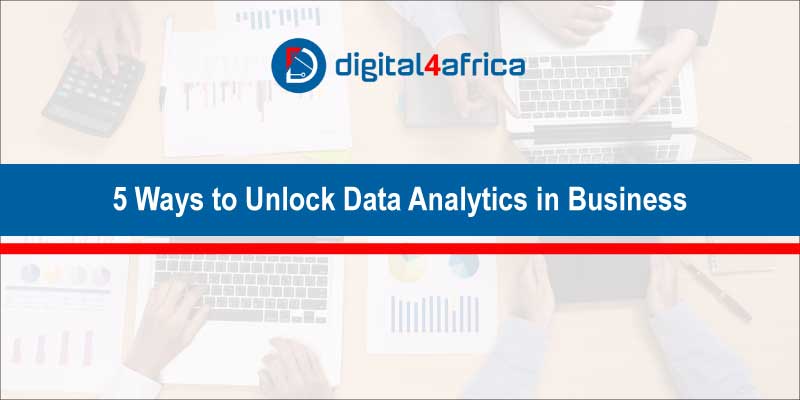Data analytics in business hugely impacts an organization’s operations in this digital era. Your business success lies in how quickly and efficiently you are at collecting and analyzing data.
For sure, proper data analytics can help your business prosper. So if you are a business owner looking for ways to unlock the potential of data analytics, or maybe you’re interested in learning more about how data science can help businesses scale and grow. Then, you’ve come to the right place.
In this blog post, we will discuss the role of data analytics in business and provide actionable insights on how to merge analytics with your business strategy. But what is data analytics?
The Definition of Data Analytics for Business
Data analytics is examining raw data and making sense of that information. Jeff Bezos elaborately illustrates this in his TED talk. (link provided at the end.)
He compared the growth of the internet to the development of electricity in the early 20th century. Just as electricity transformed daily life, the internet is changing how we do business. And at the heart of this transformation is data analytics.
Data analytics for business should not be a complex process. But many business owners fail to leverage it to improve their operations. Hence, Digital4Africa provides training and resources to unlock business value to counter this phenomenon.
One resource is the recent Digital4Africa Webinar series, which covered Why Data Analytics is Key To Unlocking Business Value.
This article extends the same and breaks down some key elements to unlocking your business data analytics.
The Bigger Picture of Data Science
Data science is a complex field that combines statistics, computer science, and domain expertise to analyze and interpret large sets of data. You can then use this information to make informed decisions and improve your operations.
Data analytics is a crucial component of data science and plays a significant role in modern businesses. By analyzing customer behavior and market trends, you can make accurate predictions and tailor your products or services to meet consumer demands better.
Additionally, data analytics can help streamline internal processes and identify areas for cost reduction. Here are ways business owners can start using data analytics to their advantage.
The Unwritten Rules Of Data Analytics
Data analytics can help businesses unlock new opportunities, increase efficiency, and drive growth. Here are five ways businesses can harness the power of data analytics:
- Develop a data-driven culture where data and analysis inform decision-making.
- Invest in tools and technology to gather and analyze relevant data.
- Hire or train specialized data analysts to interpret and present findings to stakeholders.
- Utilize data to assess and improve business processes, products, and services.
- Continuously seek out new sources and data types to stay ahead of the competition.
By embracing these strategies, businesses can harness the power of data analytics to drive growth and success.
Let’s look deeper into how you can unlock the potential of data analytics.
Develop a Data-Driven Culture Where Data and Analysis Inform Business Decision-Making
By understanding how users interact with your product or service, you can make informed decisions that improve the user experience and increase conversions. However, collecting data is not enough – it must be carefully analyzed and interpreted to be helpful.
That’s where data-driven decision-making comes in. Using data to inform your decisions, you can ensure that your service is optimized for maximum conversion rate. So how do you go about creating a data-driven culture in your organization?
I. Ask Questions Before You do the Analysis.
First, it’s crucial to ask yourself the right questions. You can use data analysis to examine information about various aspects of businesses. Asking the right questions helps you access what you want to achieve with your analytics. Do you want to describe, diagnose, predict or gain perspective about your business?
Here is an illustration of why asking the right question is essential in business analytics.
Example of Descriptive Data Analytics in Business
Descriptive analytics answers the question: what has happened? This type of analytics looks at past data to understand what has happened in the past and identify trends. You can use this information to make decisions about the present and future.
For example, let’s say you own a clothing store. You might use descriptive analytics to examine your sales data from the past year to identify trends. Maybe you notice that sales spike during the summer months and drop during the winter months.
With this information, you can make decisions about inventory levels and staffing. You might also choose to stock more items during the summer and hire additional staff members during those months.
Example of Predictive Data Analytics in Business
Predictive analytics answers the question: what could happen? Unlike descriptive analytics, which looks at past data, predictive analytics uses historical and current data to predict future events.
Continuing with our clothing store example, let’s say you use predictive analytics to examine your sales data from the past year and current trends. Based on this information, you might predict that sales will increase by 5% next year. With this prediction, you can make decisions about inventory levels and staffing. You might choose to add stock items in anticipation of increased sales or hire additional staff members so that you can provide better customer service.
II. Establish Processes for Collecting and Sharing
Second, you must establish processes for collecting and sharing data throughout the organization. Have a system for tracking data to be easily accessed and analyzed.
There are different ways to collect data, including surveys, customer interviews, focus groups, and web analytics. Once you’ve collected the data, you need to share it with the relevant stakeholders. You can do this through reporting or data visualization.
For example, you might use a dashboard to track customer satisfaction levels over time. You can then share the dashboard with the customer service team to see how they’re performing and identify areas for improvement.
III. Create a Feedback Loop
Finally, it would be best if you created a feedback loop so that data can inform future decision-making. This feedback loop includes four steps:
Collect data → Analyze data → Take action → Collect data.
For example, let’s say you use web analytics to track the number of visitors to your website. You notice that the number of visitors has decreased over the past month. To investigate this further, you analyze the data to see what might be causing the decrease.
Based on your analysis, you take action to improve the website. This might involve making changes to the design or adding new content. Finally, you collect data again to see if your efforts have had the desired effect.
By following these steps, your organization can develop a data-driven culture and reap the benefits of improved decision-making.
Invest in Tools and Technology But do not Obsess Over Them
When investing in the right tools and techniques for data analysis is essential first to assess the business’s specific needs. Getting caught up in the latest and greatest software is easy, but remember that sometimes the most straightforward tools can be just as helpful.
For example, you can use a simple google form to collect data from customers or employees, while excel or google sheets can assist you in analyzing that data. It is also essential to clearly understand how to effectively use the tools being invested in – investing in high-level software does not necessarily guarantee successful data analysis if one does not know how to utilize it properly.
Overall, while staying current with technological advancements and tools for data analysis is essential, it is crucial not to obsess over them. Investing strategically in solutions you can utilize effectively to meet the business’s specific needs is ultimately more beneficial.
Make Data Analytics in Business a Habit.
One-time data analytics is not enough to stay competitive in today’s business environment. To stay ahead of the competition, you must continually analyze your data and seek new sources and types of data.
Engage in regular meetings to discuss and analyze data. They can help uncover patterns and insights you may have missed during a one-time analysis. Additionally, seek out fresh perspectives and opportunities for growth.
How to Continuously Seek out New Sources and Data Types to Stay Ahead of the Competition
- One way to do this is to regularly attend industry conferences and networking events, where you can meet and exchange ideas with other professionals in the field.
- Additionally, constantly keeping up with industry news and developments can help identify emerging trends and new data sources that could benefit your business.
- Lastly, experimenting with different analysis techniques and tools can also help uncover new insights from existing data sets.
Simply relying on the same data sets over time will result in stagnation and potentially missed opportunities for improvement or expansion. Continually analyzing data and actively seeking out new sources and types of data allows you to stay agile and adapt to changes in the market.
Utilize Clean Data to Assess and Improve Business Processes, Products, and Services.
Utilizing clean data to accurately assess and improve business processes, products, and services is vital. If the data is flawed or incorrect, any insights or decisions made based on that data will also be faulty or incorrect. This concept, known as “garbage in, garbage out,” highlights the importance of clean data in information analysis.
One way to achieve clean data is by regularly auditing and updating data sources. This can include removing duplicate information, correcting inaccuracies, and ensuring all necessary information is included.
Another strategy is to implement clear policies and procedures for data collection, such as obtaining consent from individuals before collecting personal information. Adhering to privacy regulations, such as GDPR (General Data Protection Regulation), is also crucial in ensuring the integrity of the data.
Overall, ensuring data is clean and accurate is essential in conducting practical data analysis. Without clean data, any insights or decisions made will likely be incorrect.
Conclusion: A simple Data Analytics Audit for Your Business
Data analytics is a powerful tool that can help you make better decisions as a business person. You can optimize your operations for maximum efficiency and profitability by understanding past trends and predicting future events.
There are many different ways to collect and analyze data, but it is crucial to invest in solutions that will meet the specific needs of your business. Additionally, data analytics should be a continuous process – constantly seeking out new sources and types of data to stay ahead of the competition.
Finally, utilize clean data to assess and improve business processes, products, and services. By following these tips, you can ensure that data analytics is working effectively for your business. Don’t miss out on the potential benefits of harnessing the power of data – start incorporating analytics into your business today!
To learn more about making data analytics work for your business, check out our digital Analytics course or contact us today! We’re always happy to chat.
If you’re not already using data analytics in your business, now is the time to start! Thanks for reading!
This article is written by Caleb Mwenga, the lead content strategist at Digital4Africa. Research compiled by Brian Wamiori. Source: Digital4Africa


